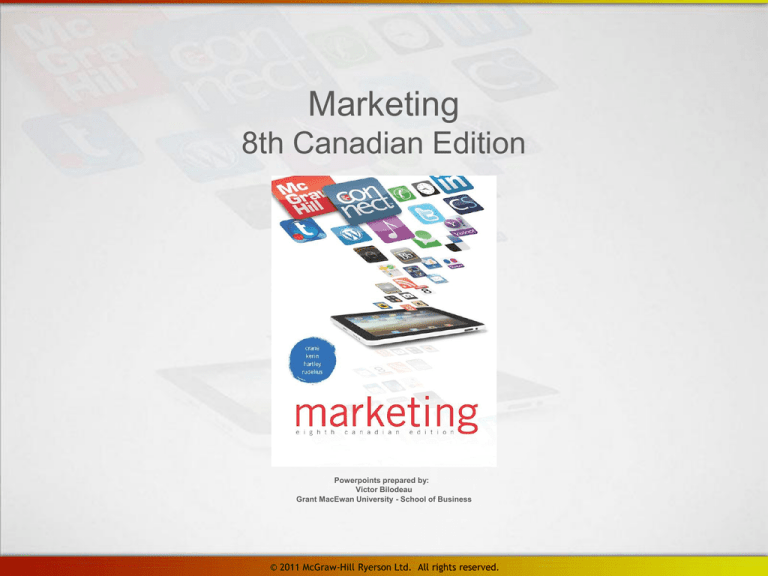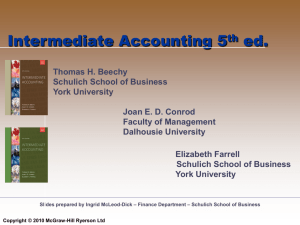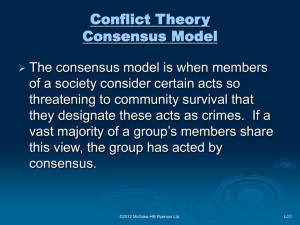
Marketing
8th Canadian Edition
Powerpoints prepared by:
Victor Bilodeau
Grant MacEwan University - School of Business
© 2011 McGraw-Hill Ryerson Ltd. All rights reserved.
Marketing: Customer
Value, Satisfaction,
Customer Relationships,
and Customer
Experiences
© 2011 McGraw-Hill Ryerson Ltd. All rights reserved.
Learning Objectives
After reading this chapter, you should be able to:
1. Define marketing and identify the requirements for successful marketing to occur.
2. Understand the breadth and depth of marketing.
3. Explain how marketing discovers and satisfies consumer needs and wants.
4. Distinguish between marketing mix elements and environmental forces.
5. Describe how market orientation focuses on creating customer value, satisfaction, and
customer relationships.
6. Explain why some organizations have transitioned from the market orientation era to the
customer experience management era.
7. Understand the emergence of the social media marketing era.
© 2011 McGraw-Hill Ryerson Ltd. All rights reserved.
What type of value do these firms
offer their customers?
© 2011 McGraw-Hill Ryerson Ltd. All rights reserved.
LO 5
WHAT MARKETING IS AND WHAT IT IS NOT
‣ Marketing: Defined
‣ The activity for creating, communicating, delivering and
exchanging offerings that benefit the organization, its
stakeholders and society at large.
© 2011 McGraw-Hill Ryerson Ltd. All rights reserved.
LO 1
WHAT MARKETING IS AND WHAT IT IS NOT
‣ Requirements for Marketing to Occur
‣
‣
‣
‣
Two or More Parties with Unsatisfied Needs
Desire and Ability to Satisfy These Needs
A Way for the Parties to Communicate
Something to Exchange
© 2011 McGraw-Hill Ryerson Ltd. All rights reserved.
LO 1
WHAT MARKETING IS AND WHAT IT IS NOT
‣ The Breadth and Depth of Marketing
‣ What is a Market?
‣ Who Markets?
‣ What is Marketed?
‣ Social Marketing
‣ Who Buys and Uses What is Marketed?
‣ Ultimate Customers
‣ Organizational Buyers
‣ Who Benefits?
© 2011 McGraw-Hill Ryerson Ltd. All rights reserved.
LO 2
WHAT MARKETING IS AND WHAT IT IS NOT
‣ The Diverse Factors Influencing Marketing Activities
© 2011 McGraw-Hill Ryerson Ltd. All rights reserved.
LO 2
FIGURE 1-1 An organization’s marketing department
relates to many people, groups, and forces
© 2011 McGraw-Hill Ryerson Ltd. All rights reserved.
LO 2
HOW MARKETING DISCOVERS AND
SATISFIES CONSUMER NEEDS
‣ Discovering Consumer
Needs
‣ Consumer Needs and
Consumer Wants
© 2011 McGraw-Hill Ryerson Ltd. All rights reserved.
LO 3
HOW MARKETING DISCOVERS AND SATISFIES
CONSUMER NEEDS
‣ Satisfying Consumer Needs
‣ Target market
‣ The Four Ps: Controllable Marketing Mix Factors
‣
‣
‣
‣
Product
Price
Promotion
Place
‣ The Uncontrollable, Environmental Factors
‣ But Wait, What About High-Technology or New-to-World
Products?
© 2011 McGraw-Hill Ryerson Ltd. All rights reserved.
LO 4
FIGURE 1-3 Marketing’s second task: satisfying consumer
needs
© 2011 McGraw-Hill Ryerson Ltd. All rights reserved.
LO 4
THE MARKETING PROGRAM
‣ The Marketing Program
‣ A Marketing Program for WildPlay Element Parks
© 2011 McGraw-Hill Ryerson Ltd. All rights reserved.
LO 4
FIGURE 1-4 Marketing Program for WildPlay Element Parks
© 2011 McGraw-Hill Ryerson Ltd. All rights reserved.
LO 4
HOW MARKETING
BECAME SO IMPORTANT
‣ Evolution of North
American Businesses
‣ Production Era
‣ Sales Era
‣ Marketing Concept Era
‣ Market Orientation Era
‣ Customer Value
‣ Customer Satisfaction
‣ Customer relationship
management (CRM)
‣ Customer lifetime value (CLV)
‣ eCRM
‣ Interactive marketing
© 2011 McGraw-Hill Ryerson Ltd. All rights reserved.
LO 4,5
HOW MARKETING
BECAME SO IMPORTANT
‣ Evolution of North American Businesses cont.
‣ Customer Experience Management Era
‣ Customer Experience Management (CEM)
‣ Social Media Marketing Era
‣ Social Media Marketing
© 2011 McGraw-Hill Ryerson Ltd. All rights reserved.
LO 6, 7
Review Questions
‣ What is marketing?
‣ What is the focus of marketing?
‣ What are the factors required for marketing to take
place?
‣ What are the controllable and uncontrollable factors
in marketing?
‣ What is marketing mix?




